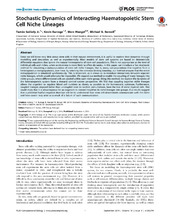| dc.contributor.author | Székely, Tamás | eng |
| dc.contributor.author | Burrage, Kevin | eng |
| dc.contributor.author | Mangel, Marc | eng |
| dc.contributor.author | Bonsall, Michael B. | eng |
| dc.date.accessioned | 2015-03-31T09:30:02Z | |
| dc.date.available | 2015-03-31T09:30:02Z | |
| dc.date.issued | 2014-09-04 | eng |
| dc.identifier.issn | 1553-734X | en_US |
| dc.identifier.uri | http://hdl.handle.net/1956/9711 | |
| dc.description.abstract | Since we still know very little about stem cells in their natural environment, it is useful to explore their dynamics through modelling and simulation, as well as experimentally. Most models of stem cell systems are based on deterministic differential equations that ignore the natural heterogeneity of stem cell populations. This is not appropriate at the level of individual cells and niches, when randomness is more likely to affect dynamics. In this paper, we introduce a fast stochastic method for simulating a metapopulation of stem cell niche lineages, that is, many sub-populations that together form a heterogeneous metapopulation, over time. By selecting the common limiting timestep, our method ensures that the entire metapopulation is simulated synchronously. This is important, as it allows us to introduce interactions between separate niche lineages, which would otherwise be impossible. We expand our method to enable the coupling of many lineages into niche groups, where differentiated cells are pooled within each niche group. Using this method, we explore the dynamics of the haematopoietic system from a demand control system perspective. We find that coupling together niche lineages allows the organism to regulate blood cell numbers as closely as possible to the homeostatic optimum. Furthermore, coupled lineages respond better than uncoupled ones to random perturbations, here the loss of some myeloid cells. This could imply that it is advantageous for an organism to connect together its niche lineages into groups. Our results suggest that a potential fruitful empirical direction will be to understand how stem cell descendants communicate with the niche and how cancer may arise as a result of a failure of such communication. | en_US |
| dc.language.iso | eng | eng |
| dc.publisher | PLoS | en_US |
| dc.rights | Attribution CC BY | eng |
| dc.rights.uri | http://creativecommons.org/licenses/by/4.0 | eng |
| dc.title | Stochastic dynamics of interacting haematopoietic stem cell niche lineages | en_US |
| dc.type | Peer reviewed | |
| dc.type | Journal article | |
| dc.date.updated | 2015-03-03T15:47:00Z | en_US |
| dc.description.version | publishedVersion | en_US |
| dc.rights.holder | Copyright 2014 Székely et al | en_US |
| dc.source.articlenumber | e1033794 | |
| dc.identifier.doi | https://doi.org/10.1371/journal.pcbi.1003794 | |
| dc.identifier.cristin | 1188644 | |
| dc.source.journal | PLoS Computational Biology | |
| dc.source.40 | 10 | |
| dc.source.14 | 9 | |
| dc.subject.nsi | VDP::Mathematics and natural scienses: 400::Basic biosciences: 470::Bioinformatics: 475 | en_US |
| dc.subject.nsi | VDP::Mathematics and natural scienses: 400::Basic biosciences: 470::Genetics and genomics: 474 | en_US |
| dc.subject.nsi | VDP::Matematikk og naturvitenskap: 400::Basale biofag: 470::Bioinformatikk: 475 | nob |
| dc.subject.nsi | VDP::Matematikk og naturvitenskap: 400::Basale biofag: 470::Genetikk og genomikk: 474 | nob |

